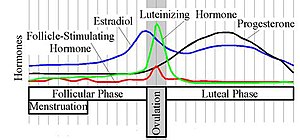 Carmen is looking at an ovulation calculator online (aka fertility days calculator), but it asks for the length of her luteal phase. What is that?
Carmen is looking at an ovulation calculator online (aka fertility days calculator), but it asks for the length of her luteal phase. What is that?
She has barely even started marking her period on the calendar, after not paying any attention to it for many years. But now she wants to get pregnant, and after a few months of no success she is looking for more information.
The point of using an ovulation calculator is to calculate when you are likely to ovulate. This is when the egg is released from the ovary, and you are fertile. If you are trying to conceive, you will be fertile a few days before ovulation and 12-24 hours afterward. This is when you need to have intercourse. You can find many free ovulation calculators online. The results will be more accurate if they include the length of your average luteal phase.
How Do I Figure My Luteal Phase for an Ovulation Calculator?
- Understand what your luteal phase is
- Recognize the signs of ovulation
- Count the days from ovulation to the start of your next period
Luteal phase is the phase of your menstrual cycle that begins after ovulation and ends the day before your next period. It typically lasts 12 to 16 days, with an average of 14 days for most women. If you do not know, you can use 14 days. Just understand that the calculation may be less accurate.
The calculator takes the length of your average menstrual cycle minus the length of your average luteal phase to estimate the day you will ovulate. Example: 28 day cycle – 13 day luteal phase = ovulate on day 15 of your cycle. You can mark this on your calendar. You will be most fertile for a couple of days before, and on, this day.
To calculate your own luteal phase length, you must be able to recognize your signs of ovulation. This skill is very important to learn when you are trying to conceive.
Read more about this in the article “What are the Signs of Ovulation“.
You can monitor changes in your cervical mucus and your cervix. You can check your saliva for a ferning pattern with a saliva ferning microscope. You can use an Ovulation Predictor Kit (OPK) to identify your LH surge, and you can monitor your temperatures with a basal body thermometer.
Now simply count the days from ovulation to the start of your next period. This is your luteal phase. Keep track for a few months, and you will soon know your average. This number tends to be fairly constant for you. Your cycle length may vary, but usually because of the first half of your cycle before you ovulate (the follicular phase).
If your luteal phase is less than 12 days, this is known as a luteal phase defect. You can read more about this in the article “What If My Luteal Phase Is Short?“. A short luteal phase may affect your ability to get pregnant, and increase the liklihood of a miscarriage if you do. There are many things you can do to help this, starting with good nutrition. It is basically a hormone imbalance issue.
If your luteal phase is normally 14 days and it has been 18 days with no period, you are likely to be pregnant.
To Your Vibrant Health!
Veronica Tilden, DO
